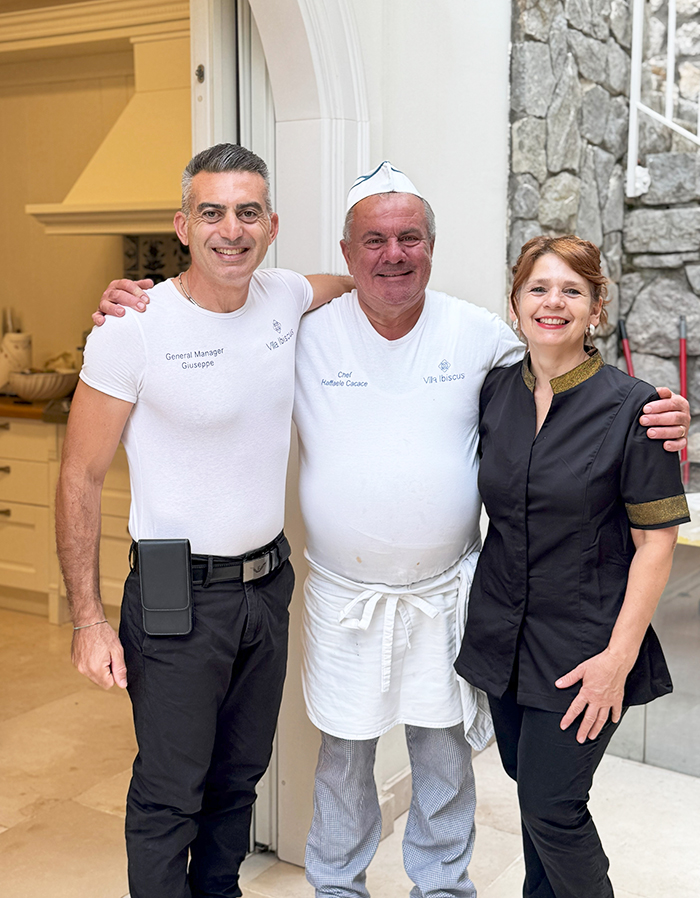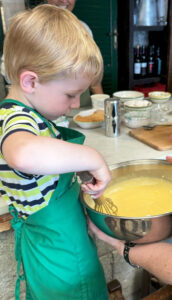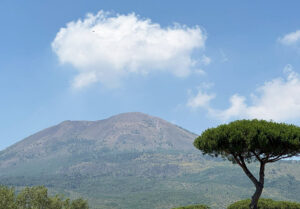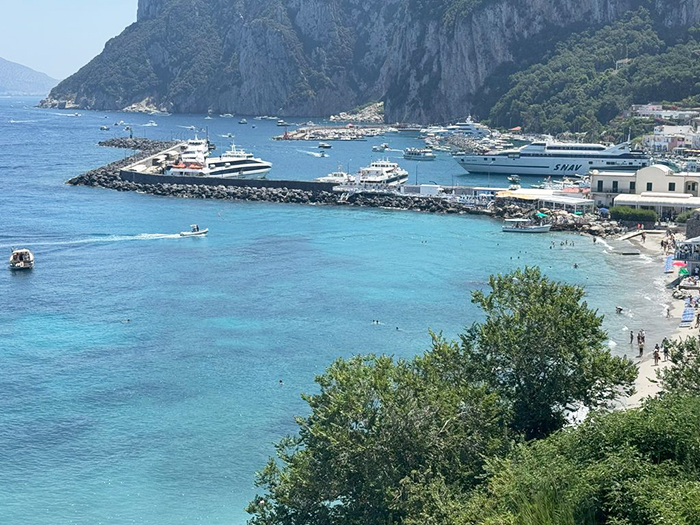 By Steven Flagg
By Steven Flagg
Guest Travel Column
Nowhere have I felt the spirit of family more deeply than in Italy. We were in Nerano, a fishing village on the Sorrento Peninsula, celebrating our 50th wedding anniversary with three generations of our family.
On a warm June evening, a short walk from our villa, we dined at Taverna del Capitano, perched over the beach with its dock in the calm Tyrrhenian Sea. We were ushered to a seaside table; dinner tasted of the coast—tomatoes, lemons, fish and wine. As we finished, a happy commotion erupted. The staff rushed out with two cakes, sparklers lit, singing “Happy Birthday” as the entire room joined in. It wasn’t either child’s birthday, just a spontaneous welcome.
That warmth followed us everywhere. Our grandson’s head was patted almost daily—by a server, a shopkeeper, even the chef who taught us to make gnocchi. I learned the head pat is a gesture of affection for children—one more way Italy made us feel at home.
As our week ended, I stepped onto the terrace one last time. Below, boats drifted; above, the cliffs of Marina del Cantone caught the first light. Our time on the Amalfi Coast was over, but its warmth, flavors, and rhythm were packed with us for the journey home.
 I thought back to our arrival at Villa Ibiscus. After the overnight flight, Giuseppe, the property manager, greeted us with a warm “Ciao!” We spoke of our week and his goal: a gracious exploration of the Amalfi Coast and nearby Naples. From the cliffs to the sea, the landscape became our daily feast.
I thought back to our arrival at Villa Ibiscus. After the overnight flight, Giuseppe, the property manager, greeted us with a warm “Ciao!” We spoke of our week and his goal: a gracious exploration of the Amalfi Coast and nearby Naples. From the cliffs to the sea, the landscape became our daily feast.
Five evenings Chef Rafael cooked for us. He didn’t speak English, but a translation app bridged the gap. He made spaghetti alla Nerano—zucchini and aged cheese turned into silk—fresh sea bass, and salads bright with lemon. I tried it three times, once at Lo Scoglio, featured in Stanley Tucci’s Searching for Italy.

Yes—the villa had a wood-fired oven, and we used it. On our last night, Rafael proofed 12 pizza doughs and fired the oven until scorching hot. We feasted on margherita, sausage, and prosciutto pizza, their crusts chewy and smoky from the flame. He delighted our grandchildren with a Nutella pizza; they dove in despite being full. We didn’t eat all twelve pizzas—but we tried. Because I’d shown interest in the dishes prepared for us, the staff gave me a ravioli cutter—a small trinket given with affection. We raised glasses of prosecco in a final toast. From pizza to pasta to a beautifully prepared Mediterranean sea bass, every meal on that terrace felt like a celebration, with the Amalfi Coast and Tyrrhenian Sea spread before us.
Our excursions were just as memorable. On a sunny morning, we chartered a 38-foot yacht to Capri to explore the coast. Andrea, our captain, met us at the pier near Lo Scoglio. We clambered aboard with “Buongiorno!” and eased along the shore, past lighthouses and sea caves—the Grotta Bianca, Grotta Verde, and the Blue Grotto—then around Punta Campanella, steeped in the myth of Ulysses and the Sirens. In the distance rose Vesuvius, the landmark that dominates the Neapolitan skyline.
 Capri was stunning if crowded. We skipped the hour-long chairlift line to Monte Solaro and chose lunch at Ristorante da Gemma on the docks. The head server flirted with my daughter and teased me—a burst of Italian hospitality. On our return to Nerano we slowed the pace, stopping at a quiet cove for a swim. My grandchildren, worn out from the morning’s excitement, napped below deck while the adults slipped into warm water, followed by cold flutes of prosecco. From the sea, Positano rose like a pastel village clinging to the cliffs. On our last day, our son, his wife, and our daughter took a water taxi there and climbed Via Trara Genoino—a steep path from the beach to the top. Having just recovered from knee surgery, I stayed at the villa with my wife and our grandchildren, relaxing by the pool and playing War, Uno, and Go Fish.
Capri was stunning if crowded. We skipped the hour-long chairlift line to Monte Solaro and chose lunch at Ristorante da Gemma on the docks. The head server flirted with my daughter and teased me—a burst of Italian hospitality. On our return to Nerano we slowed the pace, stopping at a quiet cove for a swim. My grandchildren, worn out from the morning’s excitement, napped below deck while the adults slipped into warm water, followed by cold flutes of prosecco. From the sea, Positano rose like a pastel village clinging to the cliffs. On our last day, our son, his wife, and our daughter took a water taxi there and climbed Via Trara Genoino—a steep path from the beach to the top. Having just recovered from knee surgery, I stayed at the villa with my wife and our grandchildren, relaxing by the pool and playing War, Uno, and Go Fish.
Lemons were a theme of our days, but they took center stage at Agriturismo Il Convento in Massa Lubrense. We toured a working lemon grove where the celebrated sfusato amalfitano is harvested for Il Convento’s limoncello. Under the canopy the air cooled and smelled of citrus. My grandchildren were fascinated by the machinery and enchanted by a curious peacock we came across.
We watched lemons being squeezed, touched the heavy clusters, and learned how the grove’s shade makes a microclimate. We arranged for a photographer to capture family moments—our fiftieth, and our son and daughter-in-law’s 14th anniversary—before sitting down to a simple, perfect lunch in a sunlit room. I bought a bottle of Limoncello to savor at home.
 When you think of Italy, your taste buds can’t help but stir. Few cuisines rival it for bold flavors and regional variety—from pastas and seafood to prosciutto, salamis and slow-simmered sauces. To appreciate the culinary soul of southern Italy, we joined the Marì Cooking Class at Tenuta OroVerde in Massa Lubrense. The estate is owned by Maria Amuro, who inherited her cooking and recipes from her grandmother, also named Maria. Aprons on, we dove in.
When you think of Italy, your taste buds can’t help but stir. Few cuisines rival it for bold flavors and regional variety—from pastas and seafood to prosciutto, salamis and slow-simmered sauces. To appreciate the culinary soul of southern Italy, we joined the Marì Cooking Class at Tenuta OroVerde in Massa Lubrense. The estate is owned by Maria Amuro, who inherited her cooking and recipes from her grandmother, also named Maria. Aprons on, we dove in.
Chef Sandra guided us through making tiramisu: egg yolks whisked with sugar and mascarpone; ladyfingers dipped in espresso; layers smoothed into glass dishes. My grandson worked beside me, happily topping his dessert with chocolate chips. I watched his eyes drift toward the finished cup and whispered, “Take the chips in the bowl next to you.” He grinned and popped a few in his mouth.
Next came gnocchi. We kneaded and rolled the dough, cut it into pieces (my grandson’s a little larger than most), and learned to press each pillow on the back of a fork for those classic ridges. When we finished, we carried our flour-dusted hands to a shaded garden table. The family dog lounged nearby. Lunch was our handmade gnocchi in a caprese-style sauce, topped with mozzarella and parmesan, paired with wine from the estate. Dessert was our tiramisu, now chilled and perfect. The best way to get children to try a dish? Let them help. Joyful, messy, full of flour-covered hands and laughter.
I saved for last what fascinated me most—Herculaneum, a Roman city buried beneath 60 feet of volcanic material in the eruption of 79 AD. While smaller than Pompeii, Herculaneum is far better preserved. It was rediscovered in 1709 when a worker digging a well in Resina (now Ercolano) struck marble from the ancient city below. Wanting context, we engaged a local guide who brought the ruins to life. The frescoes were astounding—reds, blues, and golds still glowing after nearly two millennia.
In the House of Neptune and Amphitrite we found the mosaic nymphaeum; in the College of the Augustales, Hercules stared back from the walls. The House of the Mosaic Atrium sparkled with black-and-white tilework; the House of the Deer opened into sweeping spaces framed by columns and sculpture. We marveled at the preserved wooden screen in the House of the Wooden Partition, stepped into ornate public baths, peeked into a thermopolium where Romans once grabbed lunch, and paused in the open-air Palaestra.
But the most powerful moment came at the ancient shoreline. There, under the arches of the boat sheds, we came upon the skeletons, the remains of hundreds who had sought shelter as the eruption descended. My three-year-old grandson reached toward one and had to be reminded, gently, “Don’t touch.” Just what you’d expect from a curious child trying to touch the past. It was a haunting contrast to the beauty above—the art, the elegance, the everyday Roman life preserved in such detail. Herculaneum left us awed—not only by what survived, but by the silence that still hangs in the air, a reminder of lives interrupted yet somehow still speaking.
 After our tour we enjoyed lunch at Cantina del Vesuvio Winery, seated on a rooftop terrace with a sweeping view of the vineyard and, beyond it, Vesuvius, looming silent. The mountain shapes so much of Campania’s history and even its soil, which gives the region’s wines their character. We clinked glasses and looked back past the vineyard to Vesuvius.
After our tour we enjoyed lunch at Cantina del Vesuvio Winery, seated on a rooftop terrace with a sweeping view of the vineyard and, beyond it, Vesuvius, looming silent. The mountain shapes so much of Campania’s history and even its soil, which gives the region’s wines their character. We clinked glasses and looked back past the vineyard to Vesuvius.
As we left the villa that Saturday morning, surrounded by beauty, I kept returning to one thing: I was with a family that grew from a marriage spanning 50 years. It felt like being wrapped in a soft cocoon—warm with joy and shared memory. The flavors of the Amalfi Coast may fade from our taste buds, but not from our hearts. We’d go back; it was a five-star experience. Still, it may be time to plan our next adventure—perhaps a river cruise down the Danube for my wife and me, a family trip to the French countryside, or something closer to home—a tour of the history of the Hudson Valley.
Happy travels.

